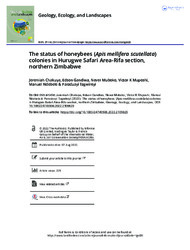| dc.contributor.author | Chakuya, Jeremiah | |
| dc.contributor.author | Gandiwa, Edson | |
| dc.contributor.author | Muboko, Never | |
| dc.contributor.author | Muposhi, Victor K | |
| dc.contributor.author | Ndebele, Manuel | |
| dc.contributor.author | Tagwireyi, Paradzayi | |
| dc.date.accessioned | 2022-09-28T09:11:00Z | |
| dc.date.available | 2022-09-28T09:11:00Z | |
| dc.date.issued | 2022-08-07 | |
| dc.identifier.citation | Chakuya, J., Gandiwa, E., Muboko, N., Muposhi, V. K., Ndebele, M., & Tagwireyi, P. (2022). The status of honeybees (Apis mellifera scutellata) colonies in Hurugwe Safari Area-Rifa section, northern Zimbabwe. Geology, Ecology and landscapes, 1-11. | en_US |
| dc.identifier.issn | 24749508 | |
| dc.identifier.uri | 10.1080/24749508.2022.2109829 | |
| dc.identifier.uri | https://hdl.handle.net/13049/537 | |
| dc.description | This is an Open Access article distributed under the terms of the Creative Commons Attribution License (http://creativecommons.org/licenses/by/4.0/), which permits unrestricted use, distribution, and reproduction in any medium, provided the original work is properly cited. | en_US |
| dc.description.abstract | Species Distribution Models (SDM) play an essential role in establishing factors affecting honeybee species spatial population distribution and ensuring effective niche habitat protection. This study aimed to assess the precision of the triangulation bee lining technique in locating Apis mellifera scutellata colonies within wild habitats, locate A. m. scutellata colony site population distribution and develop a predictive model of A. m. scutellata habitat suitability using SDM algorithms within Hurugwe Safari Area (HSA)-Rifa section, northern Zimbabwe. A survey of A. m. scutellata was carried out between February and October 2019. The triangulation bee lining technique was used to track wild bees to their colony sites. The bee lining technique was evaluated to assess its precision in locating honeybee colonies. Ensemble models were used to develop a predictive suitability niche ecosystem for A. m. scutellata nesting sites. The study located wild honeybee colonies using the triangulation bee lining technique with an 18% accuracy. Bee colonies were found at a mean distance of 27.7 m ± 2.06 from triangulated points. The predicted suitable areas were primarily areas close to the water sources and low-lying areas. The study recommended the use of the triangulation honeybee hunting method in locating wild honeybee colonies for research purposes, wild bee colony inspection for pests and diseases and sustainable organic honey collection. | en_US |
| dc.language.iso | en | en_US |
| dc.publisher | Taylor & Francis Online | en_US |
| dc.relation.ispartofseries | Geology, Ecology landscapes;1-11. | |
| dc.subject | Bee lining | en_US |
| dc.subject | Habitat | en_US |
| dc.subject | Honeybee | en_US |
| dc.subject | Modelling | en_US |
| dc.subject | Triangulation | en_US |
| dc.title | The status of honeybees (Apis mellifera scutellata) colonies in Hurugwe Safari Area-Rifa section, northern Zimbabwe. | en_US |
| dc.type | Article | en_US |

